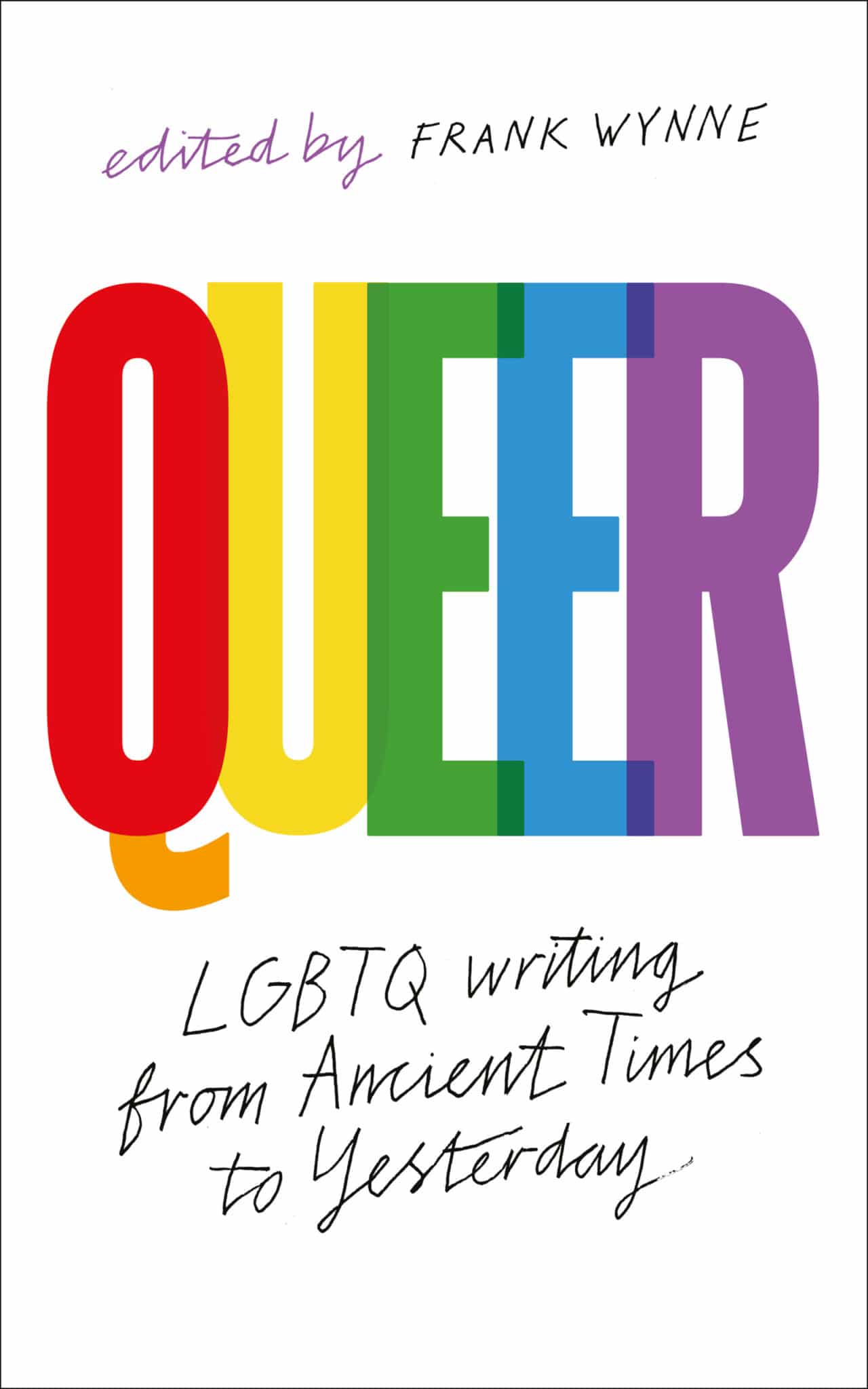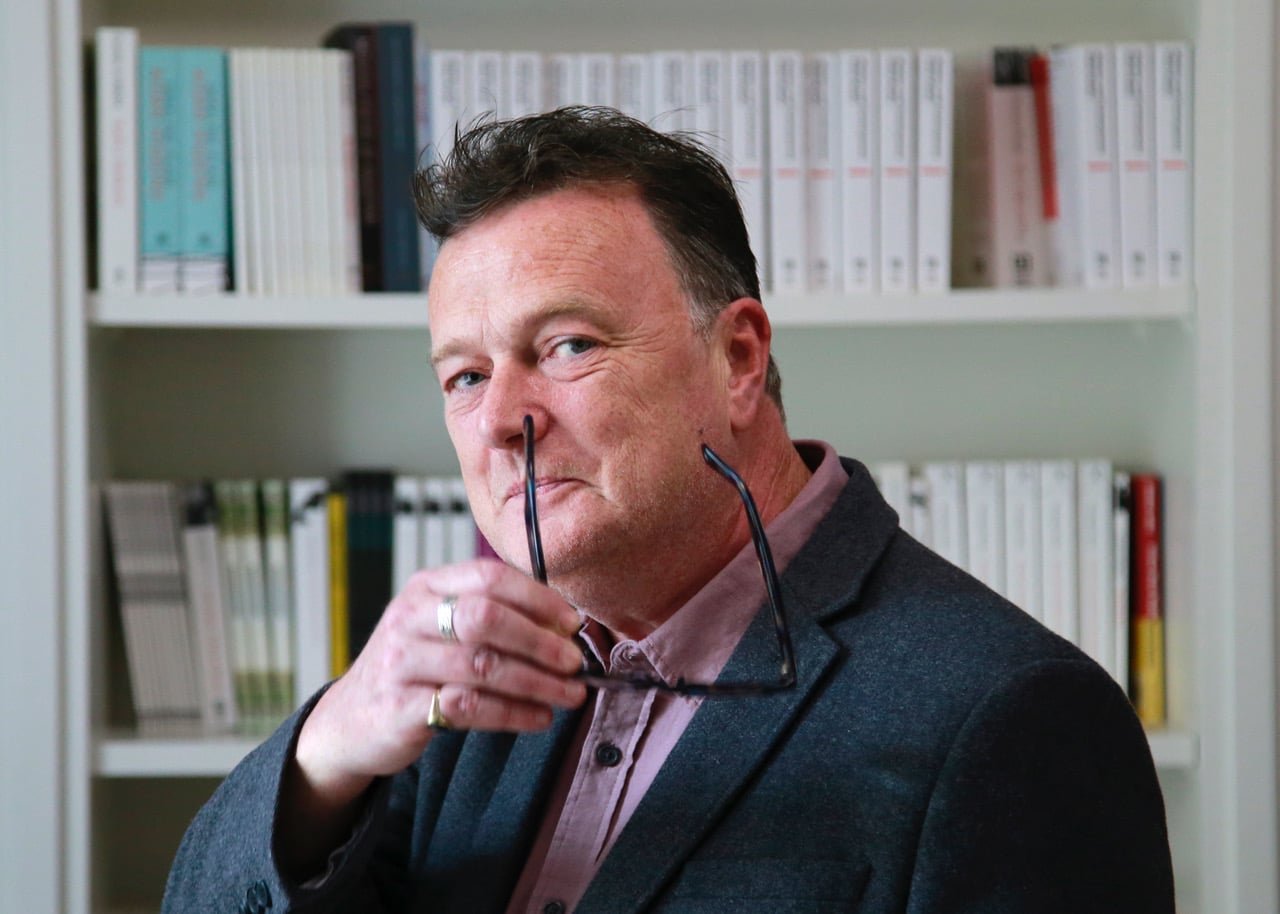Frank Wynne has published a new anthology called Queer, including LGBT+ voices from ancient times to th present day. (Nick Bradshaw/Provided)
When writer and editor Frank Wynne announced he had compiled an anthology of LGBT+ writing, not everyone was convinced that such a book was necessary.
Several weeks ago, Wynne shared with Twitter details of Queer: LGBTQ Writing from Ancient Times to Yesterday, an astonishing book running more than 600 pages long, spanning queer writings ranging from the eighth century BC right up until the present day.
After he posted, somebody replied: “Isn’t it sad that we still need an anthology for LGBT+ writers?”
Many would see the question as tone deaf – some might even consider it offensive – but Wynne took a different approach.
“I said, well, on the one hand, I agree. And on the other, I talk to my LGBT friends, and they get told by publishers: ‘We’ve already got a trans poet,’ or, ‘We’ve already got a Black gay writer,’ to which my only possible answer is: ‘You’ve already got a hundred cis, white, heterosexual male writers. What is your point?’”
The problem, he says, is that queer literature is still considered “niche”, and as a result, LGBT+ stories often go unpublished and unheard. This is is exactly why anthologies like Queer are still needed today.
“I mean, I agree with this person on Twitter,” Wynne tells PinkNews. “Ideally, books would be published because they’re good – because they’re interesting, because the editor who reads them is passionate about them and wants other people to read them. And readers would read books because they’re interesting, or passionate, or whatever, and they wouldn’t think, ‘Is this attempting to make a point?’”
But we are not there yet, Wynne says. “Even, what, 30 years after Section 28 and all of that b*****ks, you still get a very vocal minority on Twitter and social media talking about the ‘liberal agenda’ or the ‘gay agenda’ or the ‘trans agenda’, and actually, it’s like, ‘What we’d really like is for everyone to treat everyone like people. If you can do that, we’re good.’”
The library allowed Frank Wynne to explore his sexuality as a teenager.
Queer includes poetry, diary entries and excerpts from novels, all exclusively by queer writers – or at least, by writers who can be read as LGBT+, such as William Shakespeare, Emily Dickinson and Homer.
Wynne spent two-and-a-half years researching and reading queer writers from across the world in compiling his book – but in truth, his foray into LGBT+ writing began many years before when he was growing up in County Sligo in the west of Ireland. Born in the 1960s, Wynne grew up in a small town in a country that was entrenched in Catholicism. It wasn’t an easy place or time to grow up gay – and the library provided much-needed solace. It was there that he first stumbled across the definition of homosexuality in an encyclopaedia.
“It was written in fairly judgemental language,” he recounts. “It was still considered a mental illness at the time – but at the foot of the entry, it said, see also: homosexual writers. I thought, ‘OK, there are homosexual writers. I wonder who they are.’”
The library in his hometown was a deconsecrated church, so he assumed that they would not stock any queer writers – but he was quickly proven wrong. It quickly became a lifeline, allowing him to delve into the works of Oscar Wilde, Virginia Woolf and others. But having access to queer literature at that time was not a given.
“There was still an index of banned books in Ireland until probably the early ’90s. It might even be later than that. So when John McGahern wrote The Dark in 1966, a wonderful novel, he was fired as a teacher, and refused ever to be allowed to work in the civil service or the teaching profession ever again. And his book was put on the index of banned books, as was Edna O’Brien’s The Country Girls. Ireland was still quite happily saying: ‘You cannot read this book.’”

However, this meant that if a book had managed to avoid controversy, it would still be stocked in the library. The result was that a young Wynne was happily able to access the works of Mary Renault, who attracted a large gay following with her forthright depictions of homosexuality. Her books were a far cry from most queer literature at the time, which largely followed “sad homosexuals who come to sad ends”, Wynne says.
For a long time, Wynne would withdraw books from the library and put the wrong book sleeve on them, so nobody knew what he was reading.
I’d phone people’s parents and say: ‘Ben’s funeral is next week, I’m really sorry to say that your son is dead.’ And they’d say: ‘Yeah, I think we’re busy that weekend.’
“It’s a very small town, everyone knows everyone, and what would the neighbours think? Even if I didn’t care, I was terrified that my mother would care. I knew enough about the world to know that it was entirely possible that you could be disowned, that you could be thrown out. A decade later, when I was living in London in the AIDS crisis, I used to phone people’s parents and say: ‘Ben’s funeral is next week, I’m really sorry to say that your son is dead.’ And they’d say: ‘Yeah, I think we’re busy that weekend.’”
Wynne believes that most queer people over the age of 50 probably “first discovered their sexuality through books”. Looking back, he feels that an anthology like this one would have been an “extraordinary thing” for people of his generation.
“On the other hand, whether I would have dared take it out of the library, I don’t know – certainly not if it had the word ‘queer’ in rainbow colours on the front of it.”
In later years, as Wynne explored queer literature further, he began to notice that tropes and stereotypes abounded.
“Up to the 1950s, or 1960s, we were evil. If we appeared in books then we had to die. If we appeared in crime fiction, we definitely had to die – or we killed people. By the early ’70s, we were sad, tragic victims who probably killed ourselves, but if we didn’t… we languished at home listening to showtunes from the ’40s and being sad… And in time, of course, we became the incredibly harmless gay best friend who appeared in novels where we were hugely unthreatening, because actually, we might as well have been Ken dolls. We didn’t need to have genitalia since nobody was ever going to talk to us and there was never going to be another gay person in it.”
Much of this kind of literature was written by straight people, and a lot of it was aimed at straight readers, too. This is part of the reason Wynne wanted to include only queer voices telling LGBT+ themed stories in his anthology. There have been other compilations of queer work, but most have included cis and straight writers alongside queer creatives.
“I could have filled in quite a lot of gaps between ancient times and the 20th century by including a lot of straight writers writing either gay characters, or writing about homosexuality,” Wynne says. “I wanted to include someone like Mary Renault, who was hugely important to me growing up. But for once, I didn’t want to have straight people creating gay characters for gay people, or trans characters for trans people.”
There were, of course, difficult decisions to be made, particularly when it came to including long-passed writers who lived before anyone ever identified as queer. He ultimately settled on including Emily Dickinson because she wrote “passionate love letters” to her female friends, while Shakespeare is often considered to have been somewhere along the queer spectrum too.
“The notion of being queer, of being lesbian, being gay, is something that has only really existed in the 20th century. Prior to that, you might do things that were [queer] – you might have sex with a woman, or have sex with a man. You might dress as a man and pass in society as a man because you were what would later be called transgender. But this was not an identity. There was no tick box, in a sense. So there are a lot of writers where we think, ‘Well, yeah, maybe – maybe not.’ And there are a lot of writers where we think, ‘Well, yeah, it’s probably kind of undeniable.’”
There were other challenges too. While Wynne and others have settled on identifying certain authors as queer, their estates don’t always agree. He asked for permission to include one author in this anthology, but was denied because she was “not a lesbian”, according to her estate. “Despite what she wrote, despite how she lived, they did not want her associated with that,” he says.
Wynne also wanted to ensure that the anthology included a diversity of voices from various countries, not just white European ones.
“I had obviously been reading an awful lot of gay books for years, and then I discovered that actually, what I’d been doing is, I’d been reading an awful lot of Western gay books for years. There were maybe a couple of exceptions – I had read Mishima, and there were maybe a couple of Japanese writers that I had read – but I had no idea whether there were contemporary Chinese, Taiwanese, Korean, Singaporean, Cameroonian, South African, Indian, Bangladeshi and Pakistani queer writers. Because, like most of the rest of the publishing industry, that is a small part of what we do, and unless you bother to go and look for it, it’s still a small part of what we do.”
If you listen to what trans critics say now, it is exactly what was being said 30, 40 years ago about gay people.
Wynne also saw it as absolutely essential that he included a broad range of trans voices in the anthology. He has been dismayed by the small-but-vocal group of “gender critical feminists” who seem to work tirelessly to police public spaces and social media, pushing deeply conservative ideas about gender in the process.
“I’m not trying to make a statement by including trans writers – I would be making a statement if I excluded them,” he says.
“If you listen to what trans critics say now, it is exactly what was being said 30, 40 years ago about gay people,” Wynne says. “It was like, ‘Of course you couldn’t have gays in the military, it’ll undermine discipline, and besides, they’ll probably f**k each other. And you don’t want them coming out in sport, you wouldn’t want them in your changing room or locker room, they’re predatory. They will go after people. They’re dangerous.’ It’s just the same thing again.
“Sadly, we have a generation who stood and marched for women’s rights and feminist rights, and for lesbian rights and gay rights in the 1970s, who said, ‘biology is not destiny.’ And now they seem to be saying, actually, it’s not destiny unless we say it is.”
Wynne hopes readers – both LGBT+ and non-LGBT+ – can find something new in his anthology. But he also wants readers to see it as a jumping-off point. He is eager to point out that this book is the result of his own research and his own reading. The idea of an anthology is “completely artificial”, he says, but he hopes readers can embrace the “artificiality of the whole thing”.
“This is a snapshot of the world. Everyone else is absolutely welcome to go out and make another.”
Queer: LGBTQ Writing from Ancient Times to Yesterday is published by Head of Zeus.
